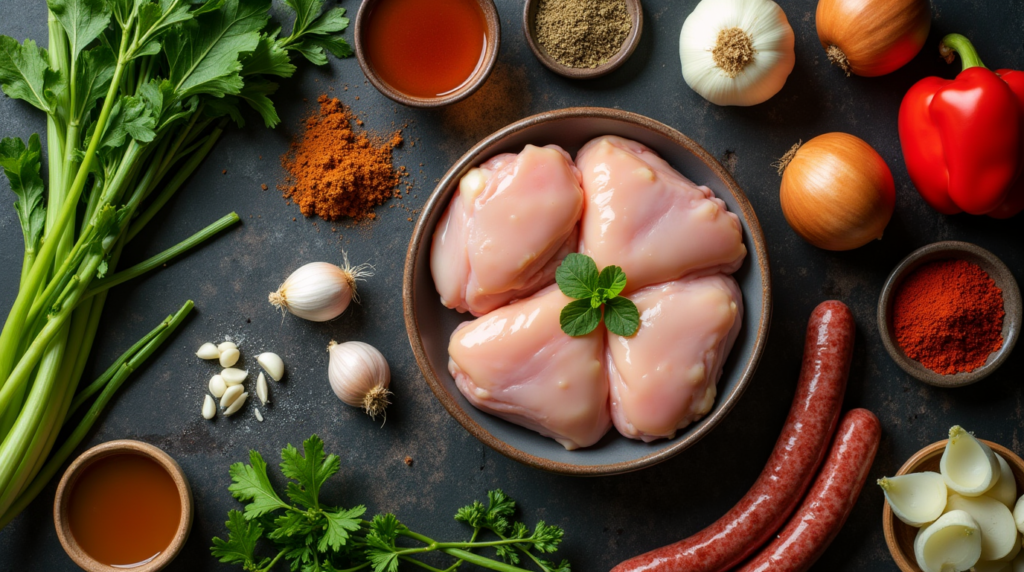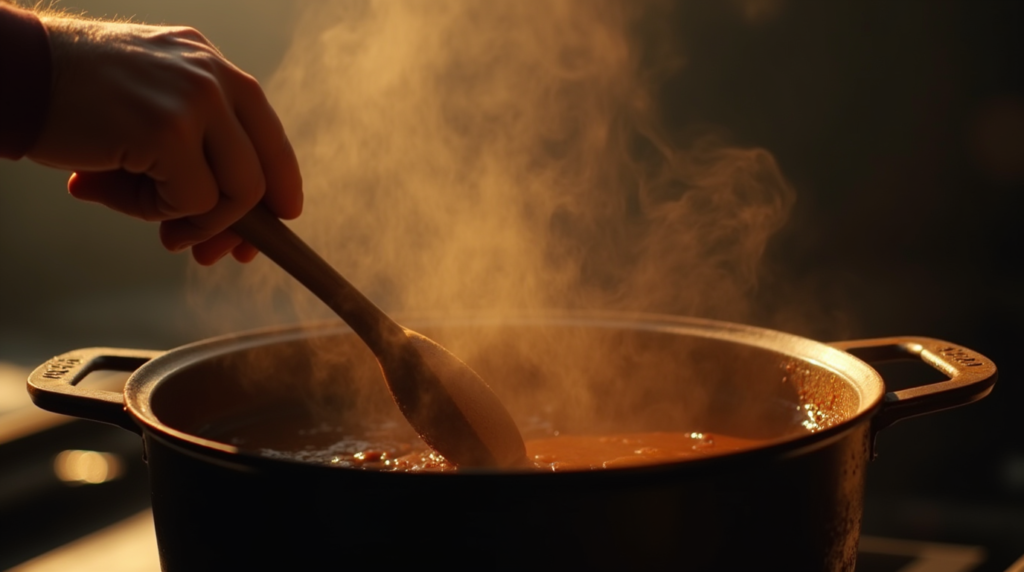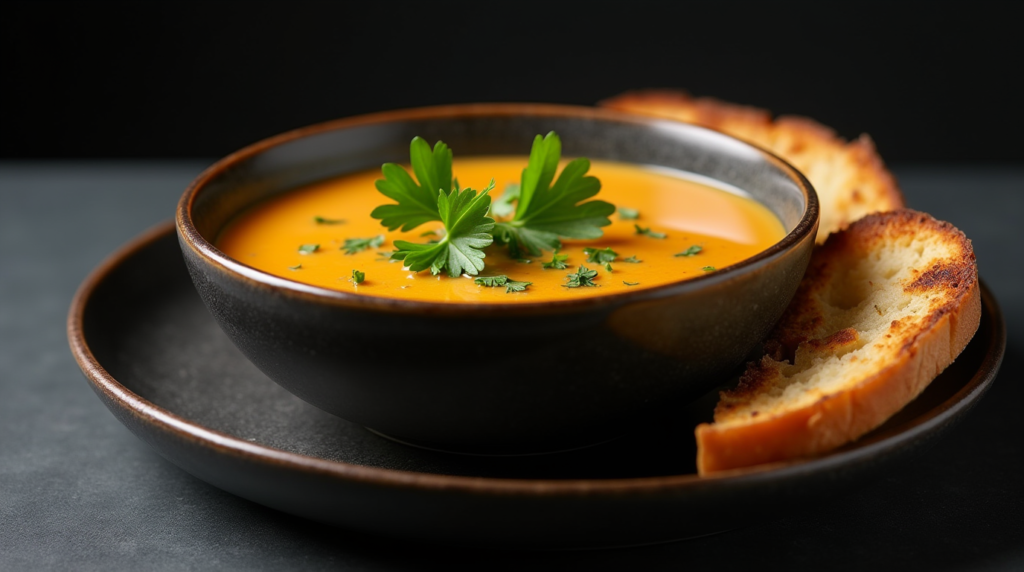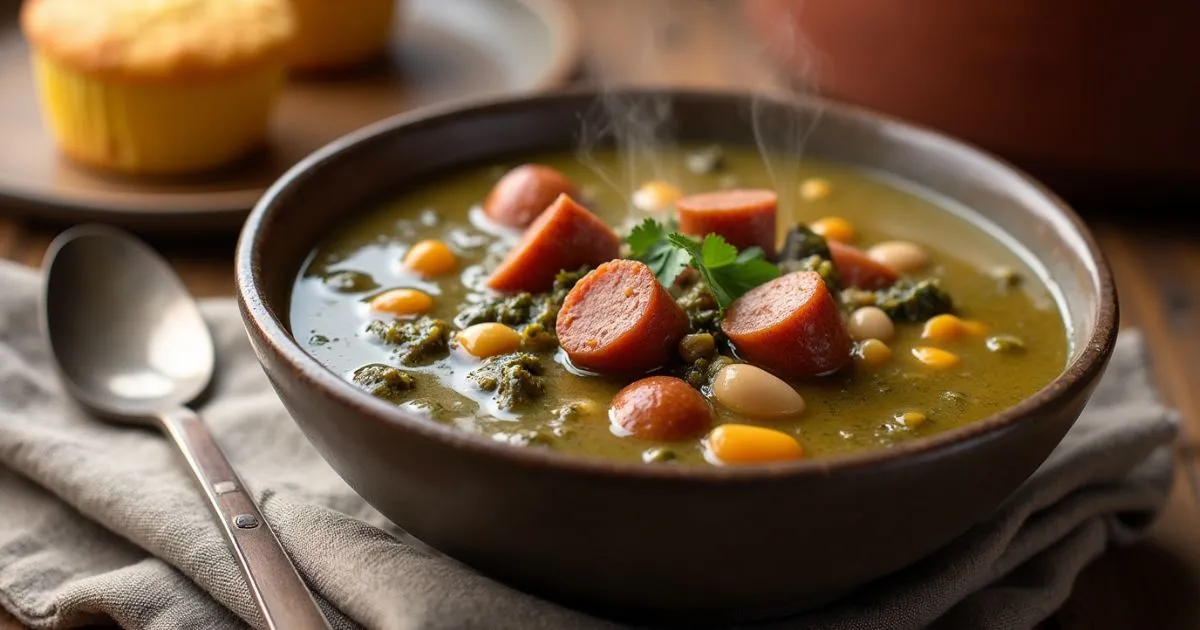What Is Swamp Soup? Discover the Origins and Recipe Basics
You’ve likely heard of swamp soup, a hearty and flavorful dish that’s deeply rooted in Cajun cuisine. But what exactly is it, and how do you make it? This traditional Cajun swamp soup recipe has been passed down through generations, and its rich history is worth exploring.
Originating in Louisiana, swamp soup is a thick and savory stew made with a variety of ingredients, including seafood, vegetables, and spices. The recipe may vary depending on the region and personal preferences, but the core elements remain the same. In this article, we’ll delve into the origins of swamp soup and provide you with the basics of making this delicious dish at home.
Key Takeaways
- Swamp soup is a traditional Cajun dish originating in Louisiana.
- The recipe typically includes a mix of seafood, vegetables, and spices.
- You can customize the recipe to suit your taste preferences.
- Swamp soup is a hearty and flavorful stew perfect for cold weather.
- Learning to make swamp soup is a great way to explore Cajun cuisine.
Understanding Swamp Soup: A Cajun Culinary Tradition
Cajun swamp soup is more than just a meal; it’s an experience deeply rooted in Southern culture. This traditional dish has been a cornerstone of Cajun cuisine, embodying the rich culinary heritage of the Louisiana bayous.
Definition and Key Characteristics
Swamp soup, also known as swamp stew, is a hearty, flavorful dish made with a variety of ingredients, including proteins such as alligator, turtle, or fish, and an assortment of vegetables and herbs. The key characteristics of this soup include its rich broth, achieved through a dark roux, and its bold, spicy flavors. The use of locally sourced ingredients and traditional cooking methods contributes to its distinct taste and cultural significance.
The preparation of swamp soup is often a communal activity, with family and friends gathering to share in the cooking process. This communal aspect is a reflection of the Cajun values of hospitality and community.
Cultural Significance in Southern Cuisine
In Southern cuisine, particularly within the Cajun and Creole traditions, swamp soup holds a special place. It is a dish that embodies the history and culture of the region, with its origins tracing back to the early days of Cajun settlement in Louisiana. The soup is not just a meal; it’s a connection to the land, the people, and their traditions.
The cultural significance of swamp soup is also reflected in its role during community gatherings and celebrations. Whether it’s a family dinner or a community event, swamp soup is often at the center, symbolizing the warmth and hospitality that are hallmarks of Southern cuisine.
Through its rich flavors and communal preparation, swamp soup continues to be a beloved and integral part of Southern culinary identity, reflecting the region’s history, culture, and values.
The Rich History of Swamp Soup
As you delve into the rich history of swamp soup, you’ll discover a culinary tradition deeply rooted in Louisiana’s bayou country. This dish has been a staple in the region for centuries, with its origins dating back to the early inhabitants of the bayou.
Origins in Louisiana Bayou Country
The Louisiana Bayou, with its vast wetlands and diverse wildlife, provided the perfect environment for the development of swamp soup. The early inhabitants of the bayou, including Native American tribes and European settlers, relied on the region’s abundant resources to create a hearty and nourishing soup. The original recipe for swamp soup was born out of necessity, using locally sourced ingredients such as alligator, fish, and various vegetables.
The use of local ingredients not only reflected the resourcefulness of the bayou’s inhabitants but also contributed to the unique flavor profile of the soup. The combination of fresh seafood, herbs, and spices created a rich and savory broth that has become a hallmark of swamp soup.
Evolution Through Generations
As generations passed, swamp soup continued to evolve, with each cook adding their own twist to the recipe. The dish became a staple in Louisiana cuisine, with its popularity spreading throughout the southern United States. The evolution of swamp soup was influenced by various cultural and social factors, including the influx of new immigrants and the availability of ingredients.
The adaptability of swamp soup is a testament to its enduring appeal. As different cultures and cuisines interacted, the recipe for swamp soup was refined and modified, resulting in a rich and diverse culinary tradition.
Historical Significance During Times of Scarcity
Throughout history, swamp soup has played a significant role during times of scarcity, providing sustenance for those in need. During the Great Depression, for example, swamp soup was a vital source of nutrition for many families. The dish was often made with readily available ingredients, such as wild game and foraged vegetables, making it a lifeline for those struggling to access food.
“Swamp soup was a staple during hard times, a reminder of the resourcefulness and resilience of the people who made it.”
Essential Ingredients for Authentic Swamp Soup

Swamp soup, a staple of Cajun cuisine, requires specific ingredients to bring out its unique flavor. The rich history and cultural significance of this dish are deeply rooted in its traditional ingredients. To make an authentic swamp soup, you’ll need to focus on the key components that give it its characteristic taste and texture.
Traditional Protein Sources
The protein sources used in swamp soup are crucial to its flavor and texture. Traditionally, crawfish, alligator, and wild game meats like rabbit or squirrel are used. These proteins not only add flavor but also reflect the cultural and geographical context of the dish. For example, crawfish are abundant in the Louisiana bayous and have become a staple in Cajun cuisine. If you’re using alligator or wild game, ensure it’s sourced sustainably and handled properly to avoid tough or gamey flavors.
For a more accessible version, you can substitute with chicken or smoked sausage, which still capture the essence of the traditional flavors. However, keep in mind that these alternatives will slightly alter the character of the soup.
| Protein Source | Flavor Profile | Texture |
|---|---|---|
| Crawfish | Rich, seafood flavor | Tender, flaky |
| Alligator | Mild, slightly sweet | Firm, chewy |
| Wild Game Meats | Robust, savory | Varies by meat |
| Smoked Sausage | Smoky, spicy | Hearty, chunky |
Vegetables and Aromatics
The vegetables and aromatics in swamp soup are just as important as the protein sources. Onions, bell peppers, and celery form the holy trinity of Cajun cooking, providing a flavorful base for the soup. Other vegetables like mushrooms and okra can be added to enhance the texture and flavor. Aromatics such as garlic and scallions are sautéed to bring out the depth of the soup.
When selecting vegetables, consider what’s in season and locally available. This not only ensures freshness but also supports the local economy and reduces the carbon footprint of your dish.
Herbs and Spices That Define the Flavor
The distinct flavor of swamp soup is largely due to its herbs and spices. Cajun seasoning, thyme, and bay leaves are staples in this cuisine. Hot peppers or hot sauce can be added to give the soup a spicy kick, characteristic of Cajun and Creole cooking. Other herbs like parsley and oregano can be used to add freshness and depth.
When combining these ingredients, it’s essential to balance the flavors. Start with a moderate amount of seasoning and adjust to taste, as the flavors will meld together during cooking.
Regional Variations of Swamp Soup
From the bayous of Louisiana to the delta regions of Mississippi and the wetlands of Florida, Swamp Soup has evolved into distinct regional interpretations that showcase local flavors and ingredients. This diversity is a testament to the dish’s adaptability and the rich cultural heritage of the Southern United States.
Louisiana Style Differences
Louisiana’s version of Swamp Soup is deeply rooted in Cajun and Creole cuisine, emphasizing a dark roux as a thickening agent and a blend of spices that reflect the state’s French, Spanish, and African influences. Key ingredients include the ‘holy trinity’ of Cajun cooking: onions, bell peppers, and celery, along with a variety of local seafood and sometimes alligator meat. The result is a hearty, flavorful soup that embodies the spirit of Louisiana’s culinary traditions.
The use of locally sourced ingredients and adherence to traditional cooking methods contribute to the unique character of Louisiana’s Swamp Soup. Seasoning plays a crucial role, with a balance of spices that enhances the overall flavor without overpowering the other ingredients.
Mississippi Delta Variations
Mississippi Delta’s interpretation of Swamp Soup reflects the region’s agricultural heritage and access to fresh catfish and other local fish species. This version tends to be lighter, with a clearer broth and a focus on the freshness of the ingredients rather than a rich, thick consistency. The use of catfish and other fish adds a unique flavor profile that distinguishes the Mississippi Delta variation from other regional interpretations.
Cooking techniques in the Mississippi Delta often involve slow simmering to extract the flavors from the bones and vegetables, resulting in a clear, flavorful broth. This method highlights the delicate taste of the fish and other ingredients.
Florida Everglades Interpretations
Florida’s Swamp Soup, influenced by the Everglades’ unique ecosystem, incorporates ingredients such as alligator, fish, and various local vegetables and herbs. This version is often characterized by its use of fresh, locally foraged ingredients and a slightly sweeter broth, reflecting the influence of tropical and subtropical flora. The incorporation of exotic ingredients like alligator adds a unique twist to the traditional Swamp Soup.
The Everglades interpretation showcases the region’s diverse wildlife and agricultural produce, blending traditional cooking methods with local flavors. This results in a distinct and flavorful variation of Swamp Soup that is quintessentially Floridian.
How to Make Traditional Swamp Soup: Step-by-Step Guide
Swamp soup, a staple of Cajun cuisine, can be made in the comfort of your own home with a few simple steps. This traditional dish has been passed down through generations, and its rich flavors and hearty ingredients make it a beloved meal for many. In this section, we’ll walk you through the process of making authentic swamp soup.
Preparing Your Base and Roux

The foundation of a great swamp soup is its roux, a mixture of flour and fat that’s used to thicken the soup. To make the roux, you’ll need to combine all-purpose flour and a fat source, such as vegetable oil or lard, in a large pot over medium heat. Stir the mixture constantly until it reaches a dark brown color, being careful not to burn it. This process can take anywhere from 10 to 30 minutes, depending on the heat and the type of fat used.
Once your roux is ready, you can slowly add in your stock, whisking constantly to avoid lumps. Bring the mixture to a boil, then reduce the heat to a simmer.
Adding Proteins and Vegetables
With your base and roux prepared, it’s time to add the proteins and vegetables that will give your swamp soup its flavor and texture. You can use a variety of ingredients, such as andouille sausage, chicken, or crawfish, along with a selection of vegetables like onions, bell peppers, and celery. Add these ingredients to the pot and simmer until they’re fully cooked.
Some recipes may also call for additional ingredients like mushrooms or okra, so feel free to experiment and find the combination that works best for you.
Simmering and Seasoning Techniques
To bring out the full flavor of your swamp soup, it’s essential to simmer it for an adequate amount of time. This allows the ingredients to meld together and the flavors to deepen. You can also add seasonings and spices to taste, such as paprika, thyme, or cayenne pepper. Be sure to taste the soup regularly as you season it to avoid over-salting.
Knowing When Your Swamp Soup Is Ready
The final step in making swamp soup is determining when it’s ready to be served. A good swamp soup should be thick and flavorful, with a rich, velvety texture. You can test the soup by checking its consistency and flavor. If it’s too thin, you can simmer it for a few more minutes to reduce the liquid. If it’s too thick, you can add a bit more stock. When the soup is ready, serve it hot, garnished with chopped scallions or parsley if desired.
The Ultimate Swamp Soup Recipe for Beginners
Swamp soup, a staple of Cajun cuisine, is easier to make than you think, and this beginner’s guide will walk you through it. This traditional Southern dish is not only delicious but also relatively simple to prepare, requiring just a few basic ingredients and some patience.
Ingredient List with Measurements
To make a classic swamp soup, you’ll need the following ingredients:
- 1 lb of andouille sausage, sliced
- 1 lb of chicken thighs, boneless and skinless
- 2 tablespoons of vegetable oil
- 1 large onion, chopped
- 3 cloves of garlic, minced
- 2 cups of mixed vegetables (such as bell peppers, carrots, and potatoes)
- 2 cups of chicken broth
- 1 teaspoon of dried thyme
- 1 teaspoon of paprika
- Salt and pepper, to taste
Equipment You’ll Need
Before you start cooking, make sure you have the following equipment:
- A large pot (at least 3-quart capacity)
- A cutting board
- A knife for chopping vegetables
- A measuring cup
- A measuring spoon
- A wooden spoon or spatula
Detailed Cooking Instructions
Now that you have your ingredients and equipment ready, let’s start cooking. Here’s a step-by-step guide:
- Heat the oil in the large pot over medium heat. Add the sliced sausage and cook until browned, about 5 minutes.
- Add the chopped onion and minced garlic to the pot. Cook until the onion is translucent, about 3-4 minutes.
- Add the chicken thighs to the pot and cook until browned on all sides, about 5-7 minutes.
- Add the mixed vegetables, chicken broth, thyme, paprika, salt, and pepper to the pot. Stir well to combine.
- Bring the mixture to a boil, then reduce the heat to low and simmer, covered, for 20-25 minutes or until the chicken is cooked through and the vegetables are tender.
- Serve hot, garnished with chopped scallions or parsley, if desired.
| Cooking Time | Servings | Calories per Serving |
|---|---|---|
| 30-40 minutes | 4-6 | 400-500 |
This easy swamp soup recipe is perfect for beginners looking to try their hand at a traditional Cajun dish. With this guide, you’ll be able to create a delicious and authentic swamp soup that’s sure to please.
Modern Adaptations of Classic Swamp Soup
As the culinary world continues to evolve, traditional dishes like swamp soup are being reimagined with modern twists. This evolution is driven by changing consumer preferences, advances in food technology, and the increasing availability of diverse ingredients.
Contemporary Ingredient Substitutions
One way to modernize swamp soup is by substituting traditional ingredients with contemporary alternatives. For example, you can replace alligator meat with more readily available protein sources like chicken or shrimp. Additionally, you can experiment with different types of vegetables, such as adding okra or other leafy greens to create a unique flavor profile.
Some other contemporary ingredient substitutions include using plant-based alternatives to traditional animal products, such as vegan sausage or tofu, to cater to the growing demand for vegan and vegetarian options. You can also experiment with different spices and seasonings, like adding a smoky flavor with chipotle peppers or a bright, citrusy note with fresh herbs like parsley or cilantro.
Healthier Swamp Soup Variations
To make swamp soup healthier, you can reduce the amount of fat used in the recipe by opting for leaner protein sources and minimizing the amount of roux. You can also add more vegetables, such as bell peppers, carrots, and celery, to increase the nutrient density of the soup. Furthermore, using herbs and spices to add flavor instead of salt can help reduce the sodium content.
Some other healthier variations include using low-sodium broth, reducing the amount of dark roux, and adding other nutrient-dense ingredients like beans, lentils, or quinoa. You can also experiment with different cooking methods, such as using a slow cooker or Instant Pot, to reduce cooking time and retain nutrients.
Fusion Approaches to Swamp Soup
Swamp soup can also be reimagined by incorporating elements from other cuisines, creating a fusion of flavors. For example, you can add Asian-inspired ingredients like soy sauce, ginger, or bok choy to give the soup a unique twist. Alternatively, you can incorporate Mediterranean flavors, such as olives, artichokes, or sun-dried tomatoes, to create a distinct flavor profile.
Some other fusion approaches include combining swamp soup with other traditional soups, like gumbo or jambalaya, to create a hearty, filling meal. You can also experiment with different types of protein, such as adding andouille sausage or crawfish, to add flavor and texture to the soup.
Nutritional Profile of Swamp Soup
As a rich and savory dish, swamp soup’s nutritional profile is multifaceted, offering various health benefits and considerations. Swamp soup, made with a variety of ingredients including proteins, vegetables, and herbs, provides a complex mix of nutrients.
Caloric and Macronutrient Breakdown
A typical serving of swamp soup can range from 400 to 600 calories, largely depending on the protein sources and ingredients used. The macronutrient breakdown includes a mix of proteins, fats, and carbohydrates, making it a relatively balanced meal. For instance, a serving might contain around 30-40 grams of protein, 20-30 grams of fat, and 20-30 grams of carbohydrates.
Vitamins and Minerals
Swamp soup is a good source of various vitamins and minerals, thanks to its diverse ingredients. Vegetables like dark leafy greens contribute vitamins A, C, and K, while proteins and other ingredients add minerals such as iron, potassium, and magnesium. The exact vitamin and mineral content can vary based on the specific ingredients and their quantities.
Health Benefits and Considerations
The health benefits of swamp soup include its potential to provide a nutrient-dense meal, support heart health through its mix of omega-3 fatty acids and antioxidants, and aid in digestion due to its fiber content. However, considerations should be given to the sodium content, especially for those with high blood pressure, and the potential for allergens or ingredients that may not be suitable for all dietary preferences or restrictions.
Common Mistakes to Avoid When Making Swamp Soup
Making swamp soup can be a straightforward process if you avoid common errors. Swamp soup, a rich and flavorful dish rooted in Cajun cuisine, requires attention to detail to bring out its best qualities. By understanding and avoiding the most common pitfalls, you can create a delicious and authentic swamp soup that honors its culinary heritage.
Ingredient Selection Errors
One of the most critical steps in making swamp soup is selecting the right ingredients. A common mistake is using low-quality or inappropriate ingredients, which can significantly affect the flavor and texture of the soup. For example, using frozen or low-grade protein sources instead of fresh ones can alter the taste and nutritional value of the soup. It’s also crucial to choose the right type of vegetables and herbs that are traditional to the dish, such as the “holy trinity” of Cajun cooking: onions, bell peppers, and celery.
To avoid ingredient selection errors, focus on sourcing the freshest and highest-quality ingredients available. This not only enhances the flavor but also ensures that your swamp soup is nutritious and safe to eat. Consider visiting local farmers’ markets or specialty stores that can provide the authentic ingredients needed for an authentic swamp soup.
Cooking Process Pitfalls
The cooking process is another area where mistakes can easily occur. One common pitfall is not cooking the roux to the correct color, which can result in an unbalanced flavor. The roux is a fundamental component of swamp soup, acting as a thickener and flavor enhancer. Cooking it to a dark brown or almost black color is typically recommended for a rich, deep flavor. Additionally, not simmering the soup long enough can lead to underdeveloped flavors and tough ingredients.
To avoid cooking process pitfalls, it’s essential to be patient and attentive. Monitor the roux’s color closely and adjust the heat as necessary. Allowing the soup to simmer for an adequate amount of time will help to tenderize the ingredients and meld the flavors together, resulting in a more satisfying and complex taste experience.
Seasoning and Balancing Flavors
Finally, seasoning and balancing the flavors in your swamp soup is crucial. A common mistake is over-seasoning or under-seasoning the soup. The key is to taste as you go and adjust the seasoning accordingly. Swamp soup should have a balance of spicy, salty, and slightly sweet flavors. Using a variety of herbs and spices, such as thyme, oregano, and cayenne pepper, can help achieve this balance.
To season your swamp soup effectively, start with a conservative amount of seasoning and gradually add more to taste. This approach allows you to avoid overpowering the other flavors in the soup. Remember, the goal is to enhance the natural flavors of the ingredients rather than overwhelm them.
Serving and Pairing Your Swamp Soup

The way you serve and pair your swamp soup can significantly enhance its flavor and overall appeal. To create a memorable dining experience, consider the traditional accompaniments, beverage pairings, and presentation tips that complement this beloved Southern dish.
Traditional Accompaniments
Swamp soup is often served with traditional accompaniments that add texture and flavor to the meal. Some popular options include:
- Crusty bread, such as French bread or cornbread, for dipping into the rich broth
- Crunchy crackers, like saltines or oyster crackers, to add a satisfying crunch
- A side of fresh greens, such as collard greens or mixed greens salad, to provide a refreshing contrast
Beverage Pairings
The right beverage can elevate the flavors of swamp soup and create a harmonious dining experience. Consider pairing your swamp soup with:
- A glass of iced tea, sweetened or unsweetened, to complement the rich flavors
- A crisp glass of white wine, such as Sauvignon Blanc or Pinot Grigio, for a more sophisticated pairing
- A refreshing glass of lemonade or flavored sparkling water for a lighter option
Presentation Tips for Home and Special Occasions
Whether you’re serving swamp soup at home or for a special occasion, presentation is key to creating a memorable experience. Consider:
- Garnishing with fresh herbs, such as parsley or thyme, to add a pop of color and freshness
- Serving in rustic bowls or hollowed-out bread loaves to add a touch of whimsy
- Creating a themed tablescape with earthy tones and natural elements to evoke the bayou atmosphere
Storing and Reheating Swamp Soup
Proper storage and reheating techniques are crucial for maintaining the flavor and quality of swamp soup. Whether you’re saving it for later or making it in bulk, understanding how to store and reheat it is vital.
Refrigeration Guidelines
To store swamp soup in the refrigerator, cool it down to room temperature first to prevent bacterial growth. Then, transfer the soup to an airtight container and refrigerate at 40°F (4°C) or below within two hours of cooking. When stored properly, swamp soup can last for 3 to 5 days in the refrigerator.
Freezing Methods for Long-Term Storage
For longer storage, consider freezing your swamp soup. Divide the soup into portions, and place them in airtight, freezer-safe containers or freezer bags. Label the containers with the date and contents, and store them at 0°F (-18°C) or below. Frozen swamp soup can be stored for 3 to 4 months.
Best Practices for Reheating Without Losing Flavor
When reheating swamp soup, do so gently to prevent the breakdown of flavors and textures. Reheat the soup over low heat, stirring occasionally, until it reaches a simmer. Avoid boiling or overheating, as this can cause the soup to lose its flavor and texture. If reheating from frozen, thaw the soup overnight in the refrigerator or thaw it quickly by submerging the container in cold water.
By following these guidelines, you can enjoy your swamp soup at a later time without compromising its quality.
Where to Find the Best Swamp Soup in America
From the bayous of Louisiana to the hidden gems across the South, the best swamp soup is a treasure worth finding. Whether you’re a food enthusiast or just discovering this Cajun culinary tradition, the following destinations are sure to satisfy your cravings.
Renowned Restaurants in Louisiana
Louisiana is the heartland of swamp soup, with numerous restaurants serving this beloved dish. Some of the most renowned establishments include:
- Jacques-Imo’s Cafe in New Orleans, known for its creative twist on traditional swamp soup.
- Coop’s Place in Baton Rouge, a casual eatery serving classic swamp soup with a side of crusty bread.
| Restaurant Name | Location | Notable Feature |
|---|---|---|
| Jacques-Imo’s Cafe | New Orleans | Creative twist on traditional swamp soup |
| Coop’s Place | Baton Rouge | Casual atmosphere and classic swamp soup |
Hidden Gems Across the South
Beyond Louisiana, the South is home to numerous hidden gems serving exceptional swamp soup. Some of these lesser-known spots include:
- The Gumbo Pot in Charleston, South Carolina, offering a unique blend of Lowcountry and Cajun flavors.
- Mama’s Kitchen in Savannah, Georgia, where swamp soup is a staple on the menu.
Festivals and Events Celebrating Swamp Soup
The South is also home to various festivals and events celebrating swamp soup, showcasing the rich culinary heritage of the region. Some notable events include:
- The annual Louisiana Swamp Soup Festival, featuring cooking competitions and live music.
- The Charleston Food Festival, which includes swamp soup as one of its highlighted dishes.
Whether you’re visiting renowned restaurants, discovering hidden gems, or attending festivals celebrating swamp soup, the best swamp soup in America is waiting to be savored. So, pack your bags, grab a spoon, and indulge in this rich culinary tradition.
Conclusion
As we’ve explored the world of swamp soup, it’s clear that this traditional Cajun dish is more than just a meal – it’s an experience. With its rich history, cultural significance, and versatility, swamp soup has become a staple in Southern cuisine. Whether you’re looking to try a delicious swamp soup at a local restaurant or make a homemade swamp soup in the comfort of your own kitchen, the possibilities are endless.
By understanding the essential ingredients, regional variations, and cooking techniques, you can create your own swamp stew that’s sure to impress. So why not give it a try? With its hearty and flavorful profile, swamp soup is perfect for a cold winter’s night or a special occasion. Invite friends and family to share in the experience, and enjoy the rich culinary heritage that swamp soup has to offer.
As you continue to explore the world of swamp soup, you’ll discover new variations and inspiration to create your own unique recipes. Whether you’re a seasoned chef or a beginner in the kitchen, the art of making swamp soup is sure to bring you joy and satisfaction. So go ahead, get cooking, and savor the flavors of this beloved Southern dish.
FAQ
What is swamp soup?
Swamp soup, also known as gumbos or Cajun swamp soup, is a hearty, flavorful stew originating from Louisiana’s Cajun and Creole cuisine. It’s made with a combination of ingredients like protein sources, vegetables, and a rich, dark roux.
What are the essential ingredients for swamp soup?
The essential ingredients for swamp soup include traditional protein sources like andouille sausage, chicken, or seafood, along with vegetables like onions, bell peppers, and celery. A dark roux made with oil and flour is also crucial, as are herbs and spices like thyme, oregano, and cayenne pepper.
Can I make swamp soup without seafood?
Yes, you can make swamp soup without seafood. While some recipes include seafood, you can substitute or omit it to suit your taste preferences. You can use alternative protein sources like chicken, sausage, or alligator meat to create a seafood-free version.
How do I achieve the characteristic dark roux for swamp soup?
To make a dark roux, slowly cook a mixture of oil and flour over medium heat, stirring constantly, until it reaches a dark brown color. This process can take about 20-30 minutes, and it’s essential to be patient and attentive to avoid burning the roux.
What are some common mistakes to avoid when making swamp soup?
Common mistakes to avoid when making swamp soup include using low-quality ingredients, not cooking the roux to the right color, overcooking or undercooking the protein and vegetables, and not balancing the flavors with the right amount of seasoning.
Can I freeze swamp soup for later use?
Yes, you can freeze swamp soup for later use. To do so, cool the soup to room temperature, then transfer it to airtight containers or freezer bags, and store them in the freezer. When reheating, simply thaw the soup overnight in the refrigerator and reheat it on the stovetop or in the microwave.
What are some traditional accompaniments to swamp soup?
Traditional accompaniments to swamp soup include crusty bread, rice, or crackers. You can also serve it with a side of cornbread, hushpuppies, or a simple green salad for a well-rounded meal.
How can I make a healthier version of swamp soup?
To make a healthier version of swamp soup, consider using leaner protein sources, reducing the amount of oil used in the roux, and adding more vegetables. You can also use herbs and spices to add flavor instead of salt and sugar.
Leave a Review & Rate This Recipe!
There are no reviews yet. Be the first one to write one.

